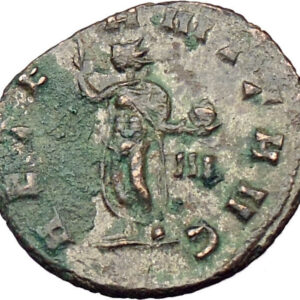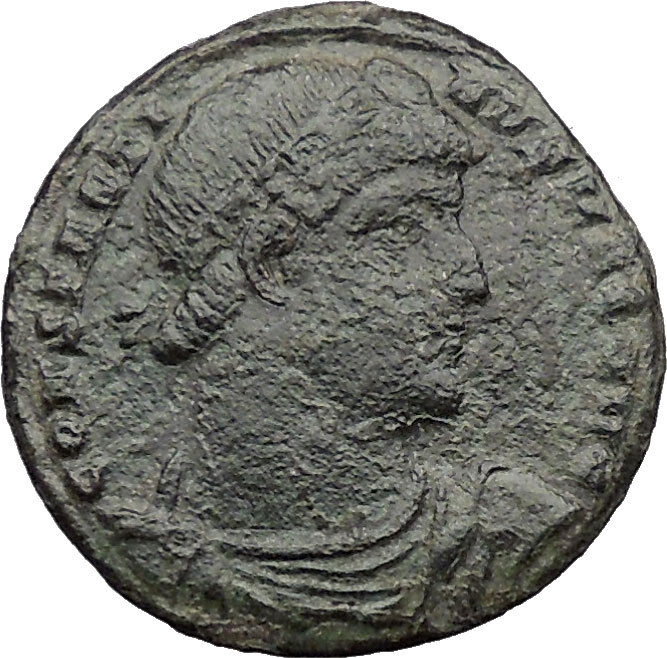|
Victorinus – Roman Gallic Emperor: 268-271 A.D.
Bronze Antoninianus 19mm (2.42 grams) Cologne mint, struck circa 268-270. A.D.
IMP C VICTORINVS P F AVG, radiate, draped and cuirassed bust right.
PAX AVG, Pax standing left, holding olive branch and sceptre.
You are bidding on the exact item pictured, provided with a Certificate of Authenticity and Lifetime Guarantee of Authenticity.
.jpg/200px-Statue_of_the_goddess_Pax_(Pavlovsk_Garden,_St_Petersburg,_Russia).jpg) In Roman mythology, Pax (Latin for peace) (her Greek equivalent was Eirene) was recognized as a goddess during the rule of Augustus. On the Campus Martius, she had a temple called the Ara Pacis, and another temple on the Forum Pacis. She was depicted in art with olive branches, a cornucopia and a scepter. There was a festival in her honor on January 3. Daughter of Jupiter and Iustitia. Pax was often associated with spring. This word is of very frequent occurrence on Roman coins, nor is it always possible to decide as to which particular pacification it is to be referred. In Roman mythology, Pax (Latin for peace) (her Greek equivalent was Eirene) was recognized as a goddess during the rule of Augustus. On the Campus Martius, she had a temple called the Ara Pacis, and another temple on the Forum Pacis. She was depicted in art with olive branches, a cornucopia and a scepter. There was a festival in her honor on January 3. Daughter of Jupiter and Iustitia. Pax was often associated with spring. This word is of very frequent occurrence on Roman coins, nor is it always possible to decide as to which particular pacification it is to be referred.
Pax, regarded by the ancients as a goddess, was worshipped not only at Rome but also at Athens. Her alter could not be stained with blood. The Emperor Claudius began the construction of a magnificent temple to her honor, which Vespasian finished, in the Via Sacra. Singular to say, no representation of the superb Temple of Peace, built by Vespasian, appears on coins of that Emperor, nor of his son Titus.–See Templum Pacis. The attributes of Peace, as exhibited on medals, are the haste pura, the olive branch, the cornucopiae; and often the caduceus. Sometimes (as on coins of Vespasian, Domitian, and M. Aurelius) she is represented setting fire to a pile of arms.
Peace was considered to be in the power of him, to whom belonged the auspices (auspicia); whence, according to Dion, the Caesars were called the Lords of Peace and War (Pacis et Belli Domini). Accordingly we find coins of the Emperors proclaiming Pax AVGusta, or AVGusti; Pax Aeterna; Pax Perpetua; Pax Fundata; Pax Publica; Pax Ubique Parta; and these inscriptions are accompanied by various symbols such as the Temple of Peace, as on medals of Augustus, or the Temple of Janus shut, as on those of Nero; or a woman holding a cornucopiae in her left hand as in Augustus, Hadrian, &c. The symbol of Eternal Peace, as manifested in the figure of the goddess setting fire to a heap of armor both offensive and defensive, is seen on coins of Galba, Vitellius, Vespasian, Antoninus Pius, and Aurelius, as in Pax Augusti. The head of pax is seen on denarii of Julius Caesar and of Augustus.
Marcus Piavonius Victorinus was emperor in the Gallic provinces from 268 to 270 or 269 to 271, following the brief reign of Marius. He was murdered by a jealous husband whose wife he tried to seduce.
Hailing from Gaul, Victorinus was born to a family of great wealth, and was a soldier under Postumus, the first of the so-called Gallic emperors. He showed considerable ability, as he held the title of tribunus praetorianorum (tribune of the praetorians) in 266/267, and rose swiftly to become co-consul with Postumus in 268. It is also possible that Postumus then elevated him to the post of praetorian prefect.
After engineering the death of Marius, Victorinus was declared emperor by the troops located at Augusta Treverorum in the fall of 269. His principal concern was to prevent the western provinces from submitting to the central authority of the Roman Empire, a fact made clear to him from the first few weeks when only the provinces of Gaul, Germania and Britain recognised him. Hispania deserted the Gallic Empire and declared its loyalty to Claudius Gothicus. Claudius then sent his trusted general Placidianus to south-east Gaul with instructions to bring over as many of the wavering cities as he could. Very quickly Placidianus captured Cularo (ancient Grenoble), but did not proceed any further.
The presence of Placidianus inspired the city of Augustodunum Haeduorum to abandon Victorinus and declare its intention to declare for Claudius Gothicus. This forced Victorinus to march south and besiege it, where it fell after seven months, after which Victorinus’ troops plundered and destroyed the city. Victorinus returned to Colonia Claudia Ara Agrippinensium in triumph. It remains a mystery just why Claudius did not authorise Placidianus to go to the relief of Augustodunum Haeduorum; however, it is speculated that Claudius, who was fully engaged either in Italy against the Alamanni or in the Balkans against the Goths, did not wish to open a second theatre of operations in Gaul, which would not only have involved a major military effort, but would also have required Claudius to assume responsibility for the defense of the Rhine frontier had he been successful. There is evidence to suggest that Claudius was having some difficulties in the East, which also occupied his attention.
Victorinus was murdered at Colonia Claudia Ara Agrippinensium in early 271 by Attitianus, one of his officers, whose wife Victorinus had supposedly seduced. Since the motive was personal and not political, Victorinus’ mother, Victoria (or Vitruvia), was able to continue to hold power after the death of Victorinus and she arranged for his deification and, after considerable payment to the troops, the appointment of Tetricus I as his successor. Another military commander appears to have been proclaimed as the emperor Domitianus II, but was soon eliminated.
Victorinus is listed among the Thirty Tyrants in the Historia Augusta. The (dubious) Historia Augusta equally has a short description of Victorinus Junior, allegedly the son of Victorinus, who was appointed emperor by his family the day his father was murdered, and would have been killed immediately afterwards by the troops. The Historia Augusta also says that both father and son were buried near Colonia Claudia Ara Agrippinensium in marble tombs.
The Gallic Empire (Latin: Imperium Galliarum) is the modern name for a breakaway part of the Roman Empire that functioned de facto as a separate state from 260 to 274. It originated during the Crisis of the Third Century.
It was established by Postumus in 260 in the wake of barbarian invasions and instability in Rome, and at its height included the territories of Germania, Gaul, Britannia, and (for a time) Hispania. After Postumus’ assassination in 268 it lost much of its territory, but continued under a number of emperors and usurpers. It was retaken by Roman emperor Aurelian after the Battle of Châlons in 274.

|





.jpg/200px-Statue_of_the_goddess_Pax_(Pavlovsk_Garden,_St_Petersburg,_Russia).jpg) In Roman mythology, Pax (Latin for peace) (her Greek equivalent was Eirene) was recognized as a goddess during the rule of Augustus. On the Campus Martius, she had a temple called the Ara Pacis, and another temple on the Forum Pacis. She was depicted in art with olive branches, a cornucopia and a scepter. There was a festival in her honor on January 3. Daughter of Jupiter and Iustitia. Pax was often associated with spring. This word is of very frequent occurrence on Roman coins, nor is it always possible to decide as to which particular pacification it is to be referred.
In Roman mythology, Pax (Latin for peace) (her Greek equivalent was Eirene) was recognized as a goddess during the rule of Augustus. On the Campus Martius, she had a temple called the Ara Pacis, and another temple on the Forum Pacis. She was depicted in art with olive branches, a cornucopia and a scepter. There was a festival in her honor on January 3. Daughter of Jupiter and Iustitia. Pax was often associated with spring. This word is of very frequent occurrence on Roman coins, nor is it always possible to decide as to which particular pacification it is to be referred.





